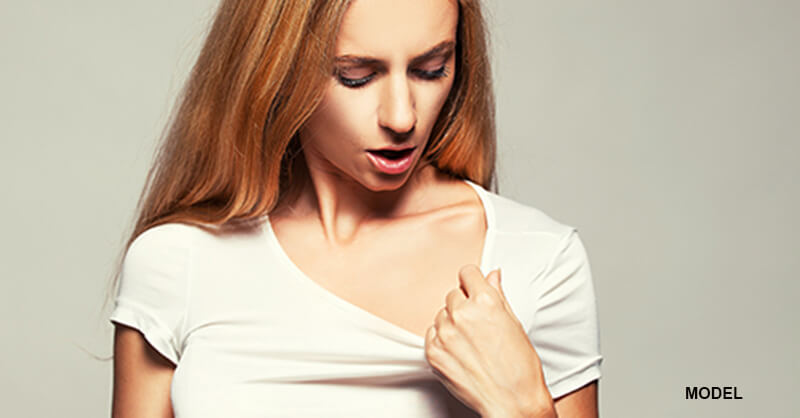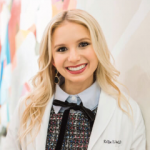Boobne (Breast Acne): Causes, Treatments, and Prevention

Recently, an interesting term has found its way into the lexicon of skincare enthusiasts: boobne, a portmanteau of “breast” and “acne.” While breast acne or chest acne has always been around, the term boobne has become so popular with Gen Z that it was recently added to Dictionary.com. In this post, we will explain what boobne is, its causes, who is more susceptible to it, prevention strategies, treatment options, and when it is time to seek professional help.
What is Boobne (Breast Acne or Chest Acne)?
Boobne, also known as breast acne or chest acne, refers to acne that develops on the chest or breast area. Like acne on the face, boobne can manifest as pimples, blackheads or whiteheads, and it can vary from mild to severe. The symptoms of boobne typically include redness, inflammation, swelling, and tenderness in the affected area.
Factors such as hormonal fluctuations, sweat, friction from tight clothing such as bras, and poor skincare habits can contribute to the development of breast acne. While anyone can experience boobne, women are more prone to it due to hormonal changes, especially during puberty, menstruation, pregnancy, or menopause.
The prevalence of boobne has increased to the extent that it was recently added to Dictionary.com, reflecting its recognition as a legitimate skincare concern.
What Causes Boobne?
Several factors contribute to the development of boobne.
- Hormonal fluctuations: Just like facial acne, hormonal changes, such as those experienced during puberty, menstruation, pregnancy, or menopause, can trigger breast acne.
- Sweat and friction: Sweat and friction from tight clothing, especially bras, can clog pores and exacerbate acne.
- Poor skincare habits: Neglecting to cleanse the chest area regularly or using harsh skincare products can contribute to pore blockage and acne formation.
Who is More Susceptible to Boobne?
While anyone can experience chest acne, certain factors may increase susceptibility.
- Gender: Women are more prone to boobne due to hormonal fluctuations, particularly during menstruation and pregnancy.
- Athletes: Individuals who engage in vigorous physical activity, such as athletes, may be at higher risk due to increased sweat and friction.
Is There a Way to Prevent Boobne?
While it may not be entirely preventable, there are steps you can take to minimize the likelihood of developing boobne.
- Wear clean, proper-fitting bras: Opt for bras made from breathable materials and ensure they fit correctly to reduce friction and sweat accumulation.
- Practice good hygiene: Shower after sweating, especially after exercise, to remove sweat and bacteria that can clog pores.
- Avoid popping pimples: Resist the urge to pop or squeeze boobne lesions, as this can worsen inflammation and lead to scarring.
- Exfoliate regularly: Incorporate exfoliating products containing beta hydroxy acids (BHAs) to unclog pores and prevent acne formation.
- Maintain a healthy diet: Limit consumption of foods high in fat, sugar, and dairy, as they may exacerbate acne.
How to Get Rid of Boobne?
If you are already dealing with breast acne, there are various treatment options available.
- Prescription medications: Dermatologists may prescribe oral antibiotics or hormonal therapies to manage severe cases of boobne.
- Topical treatments: Over-the-counter or prescription-strength topical treatments containing ingredients like benzoyl peroxide or salicylic acid can help reduce acne lesions.
- Laser treatments: Procedures such as Blu-U therapy or intense pulsed light (IPL) can target acne-causing bacteria and reduce inflammation.
- Blu-U therapy is photodynamic therapy (PDT) used to treat acne, including boobne. It utilizes blue light therapy to target and destroy acne-causing bacteria on the skin.
- IPL works by delivering high-intensity pulses of broad-spectrum light to the skin and can target acne-causing bacteria, reduce inflammation, and improve the appearance of acne lesions.
- Acne peels: Chemical peels containing ingredients like glycolic acid or trichloroacetic acid can exfoliate the skin and improve acne symptoms.
When to Consider Seeing a Dermatologist
You should consider seeing a dermatologist for boobne under several circumstances:
- Persistent symptoms: If your boobne persists despite trying various home remedies or over-the-counter treatments, it may be a sign that you need professional intervention.
- Severe symptoms: If your boobne is severe, characterized by large, painful cysts, deep nodules, or widespread inflammation, it is important to seek medical attention promptly.
- Scarring or hyperpigmentation: If boobne lesions are leaving behind scars or causing significant hyperpigmentation (dark spots) on your chest or breast area, a dermatologist can offer treatments to minimize these effects and improve the appearance of your skin.
- Worsening condition: If your boobne is worsening over time or spreading to new areas, it is a sign that your current skincare regimen may not be sufficient.
- Emotional impact: If boobne is causing emotional distress, affecting your self-esteem, or impacting your quality of life, seeking professional help is essential.
- Underlying health concerns: In some cases, boobne may be a symptom of an underlying health condition, such as hormonal imbalances or polycystic ovary syndrome (PCOS).
Patients who experience persistent, severe, or worsening symptoms of boobne, or if the condition is significantly impacting their emotional well-being, should consider setting up an appointment with a board certified dermatologist. A skilled skin care provider can provide expert guidance, personalized treatment recommendations, and ongoing support to help you effectively manage boobne and optimize skin health.
While boobne may be an uncomfortable and unsightly condition, understanding its causes, prevention strategies, and treatment options can help you effectively manage and minimize its impact on your skin health. By adopting good skincare habits and seeking professional guidance when needed, patients can achieve clearer, healthier skin on their chest and breast area.
Disclaimer: The contents of the Westlake Dermatology website, including text, graphics, and images, are for informational purposes only and are not intended to substitute for direct medical advice from your physician or other qualified professional.
